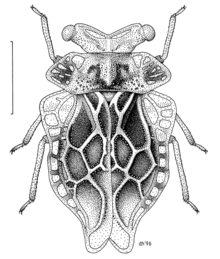Coleorrhyncha
Coleorrhyncha or Peloridiomorpha, also known as moss bugs or beetle bugs, are a suborder of Hemiptera and represent an ancient lineage of moss-feeding insects that evolved in the southern paleo-continent Gondwana. They show some similarities to the Heteroptera but have been considered distinct. It has a single extant family, the Peloridiidae. Three other families have been established on the basis of fossils and these include the more ancient (Later Permian to Jurassic) Progonocimicidae and the later Karabasiidae and Hoploridiidae. The Coleorrhyncha were earlier included within the "Homoptera" but based on studies of their morphological similarities as well as molecular phylogeny are now considered as a sister group of the Heteroptera.[1] They have wings in some species which are reduced in others but all species are flightless and live in damp moss habitats and are associated with the distribution of Nothofagus trees in Australia, New Zealand, New Caledonia, and South America.[2]
| Coleorrhyncha | |
|---|---|
 | |
| Oiophysa distincta (Peloridiidae) | |
| Scientific classification | |
| Kingdom: | Animalia |
| Phylum: | Arthropoda |
| Class: | Insecta |
| Order: | Hemiptera |
| Suborder: | Coleorrhyncha Myers & China, 1929 |
| Families | |
| |
The fossil family Progonocimicidae was formerly considered as early Heteroptera or survivors from a stem group of Heteropteroides[3] but based on morphology, Popov called them an ancestral sub-group of the Coleorrhyncha,[4] and this has been followed by subsequent authors.[5]
In 2013 a new species of Progonocimicidae, the fossil species, Cicadocoris assimilis, was discovered in rocks of the Middle Jurassic in China. It was found in the Jiulongshan Formation in Daohugou Municipality, Ningcheng County, Inner Mongolia. Previously reported as Cicadocoris Becker-Migdisova, 1958, and Mesocimex Hong, 1983, it had not been placed in the Progonocimicidae.[6]
Notes
- (Brozç, 2007)
- (Szwedo, 2011)
- Hennig, Willi (1981). Insect Phylogeny. New York: Wiley. ISBN 978-0-471-27848-1. Translated by A. C. Pont. Originally published in 1969 as Die Stammesgeschichte der Insekten Frankfurt, Waldemar Kramer
- (Popov, 1981)
- (Wheeler, 1993)(Brozç, 2007)(Heads, 2008)(Szwedo, 2011)
- (Dong, 2013)
References
- Brożek, Jolanta (2007), Labial sensillae and the internal structure of the mouthparts of Xenophyes cascus (Bergroth 1924)(Peloridiidae: Coleorrhyncha: Hemiptera) and their significance in evolutionary studies on the Hemiptera (PDF)
- Dong Qiu-ping; Yao Yun-zhi; Ren Dong (2013). "A new species of Progonocimicidae (Hemiptera, Coleorrhyncha) from the Middle Jurassic of China". Alcheringa: An Australasian Journal of Palaeontology. 37 (1): 31–37. doi:10.1080/03115518.2012.701486.
- Heads, Sam W. (2008). "A new species of Yuripopovia (Coleorrhyncha: Progonocimicidae) from the Early Cretaceous of the Isle of Wight" (PDF). British Journal of Entomology and Natural History. 21: 247–253. Archived from the original (PDF) on 2013-12-19.
- Hoch, H. (2006). "Vibrational signalling in a Gondwanan relict insect (Hemiptera: Coleorrhyncha: Peloridiidae)". Biology Letters. 2 (2): 222–224. doi:10.1098/rsbl.2006.0451. PMC 1618915. PMID 17148367.
- Myers, John Golding; China, William Edward (1929). "The systematic position of the Peloridiidae as elucidated by a further study of the external anatomy of Hemiodoecus leadi China". Annals and Magazine of Natural History. 105 (3): 282–294. doi:10.1080/00222932908672971.
- Popov, Yu A. (1981). "Historical development and some questions on the general classification of the Hemiptera". Rostria. 33 (Supplement): 85–99.
- Popov, Yu A.; Shcherbakov, Dmitry E. (1991). "Mesozoic Peloridioidea and their ancestors (Insecta: Hemiptera, Coleorrhyncha)". Geologica et Palaeontologica. 25: 215–235.
- Popov, Yu A.; Shcherbakov, Dmitry E. (1996). "Origin and evolution of the Coleorrhyncha as shown by the fossil record". In Schaefer, Carl W. (ed.). Studies on Hemipteran Phylogeny. Lanham, Maryland: Entomological Society of America. pp. 9–30. ISBN 978-0-938522-54-6.
- Shcherbakov, Dmitry E. (2005). "Fossils versus molecules and cladistics: controversies over the Hemiptera phylogeny". 12th International Auchenorrhyncha Congress, Berkeley, Volume 7.
- Szwedo, Jacek; Azar, Dany; Ziadé, Kamil (2011). "The first Progonocimicidae (Insecta: Hemiptera: Coleorrhyncha) from Lower Cretaceous Lebanese amber". Insect Systematics & Evolution. 42 (2): 161–177. doi:10.1163/187631211x578415.
- Wang, Bo; Szwedo, Jacek; Zhang, HaiChun (2009). "Jurassic Progonocimicidae (Hemiptera) from China and phylogenetic evolution of Coleorrhyncha" (PDF). Science in China Series D: Earth Sciences. 52 (12): 1953–1961. doi:10.1007/s11430-009-0160-6. Archived (PDF) from the original on 19 December 2013.
- Wheeler, Ward C.; Schuh, Randall T.; Bang, Ranhy (1993). "Cladistic relationships among higher groups of Heteroptera: congruence between morphological and molecular data sets". Insect Systematics & Evolution. 24 (2): 121–137. doi:10.1163/187631293X00235.